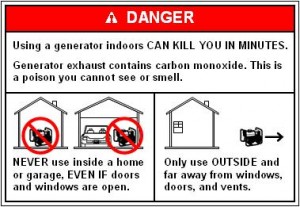By Gordon S. Johnson, Jr.
800-992-9447
Yesterday I blogged about six deaths in Fenton Township, Michigan resulting from operating a portable generator used in a basement after a power outage. Click here for yesterday’s post. Each time there is a major power outage after a natural disaster, I worry the next day’s headlines will tell of another carbon monoxide catastrophe. Too many people’s first instinct when they lose power is to plug in a portable generator to replace power. For practical reasons, those generators are too often placed in garages or basements. When the basement or garage shares an atmosphere with the living portions of a home, death or severe poisonings are likely to result.
This risk is so apparent that the Consumer Products Safety Commission has devoted an entire portion of its webpage to warning about such risks. See http://www.cpsc.gov/en/Safety-Education/Safety-Education-Centers/Carbon-Monoxide-Information-Center/Generators-and-Engine-Driven-Tools/ The CPSC includes this warning:
Yes. The CPSC required warning label warns consumers that using a portable generator indoors can KILL IN MINUTES. One could ask how someone could be so stupid to use a product in exactly the way it is warned not to be used. But the better question is why do generator manufacturers continue to manufacture something so dangerous that it can KILL in minutes? Is it not foreseeable that generators will be used in basement or garages? If it weren’t foreseeable, why put it on the warning label?
Most states recognize the doctrine of strict liability for dangerous products. Clearly, carbon monoxide generators are dangerous products. They can KILL IN MINUTES. Not all dangerous products are outlawed, however. Under general tort law, manufacturers have a three tiered responsibility with respect to dangers associated with a product. First, the manufacturer has a duty to try to eliminate the danger. If the danger inherent in a product can’t be eliminated, then the manufacturer has a duty to guard against the danger. That is why saws have guards on them. Finally, if and only if, the danger can’t be eliminated or guarded against, then the manufacturer has a duty to warn about the danger.
Clearly, this CPSC warning label is an attempt to do the last. But this warning is not sufficient. We know it isn’t sufficient because people keep dying. An effective warning would be an alarm when CO levels get dangerously high. A carbon monoxide alarm is what should be the standard of safety in the industry.
Ten years ago when I started blogging about carbon monoxide poisoning, there were relatively few laws requiring carbon monoxide detectors. Now, such laws are common place and it would be difficult for a landlord or a home inspector to argue that carbon monoxide detectors are not the safety standard for inside air quality. Just this year the State of Illinois passed a law requiring them in schools, as a result of the poisonings in our case in Girard, Illinois. Click here for more on Girard.
We simply can’t wait ten more years, hundreds of more deaths, before portable generator manufacturers stop making products that can kill in minutes. The state of art portable generators are cable of eliminating 99% of carbon monoxide. See Kohler’s Low CO Generators. That means even if the consumer operates the portable generator in the basement, it would take a substantial time for the levels to become dangerous. What might be a dangerous level of 300 ppm would become a relatively harmless 3 ppm.
A low carbon monoxide generator should not be a luxury item. It should be the only such item. Riding in a car without your seatbelt won’t necessarily kill you in minutes, yet we mandate seatbelts, like we mandate airbags and child car seats.
But even if it is arguably one step too far to mandate low carbon monoxide generators, it is not too far to mandate carbon monoxide detectors on all portable electric generators. Reengineering the entire engine is a far more complicated process than simply putting an alarm on the generator when emissions exceed a safe level. If the reason for not putting CO alarms on generators is that they would always be going off, isn’t that a good reason to stop making such products. Simply plastering a sticker on the side of the box is not adequate.
It is time to mandate no more high carbon monoxide generators. Further, our legal system does not need to wait for legislators to pass such a ban. The court system, through an imposition of strict liability for all carbon monoxide deaths and brain damage can achieve that result.


Leave a Reply
Want to join the discussion?Feel free to contribute!